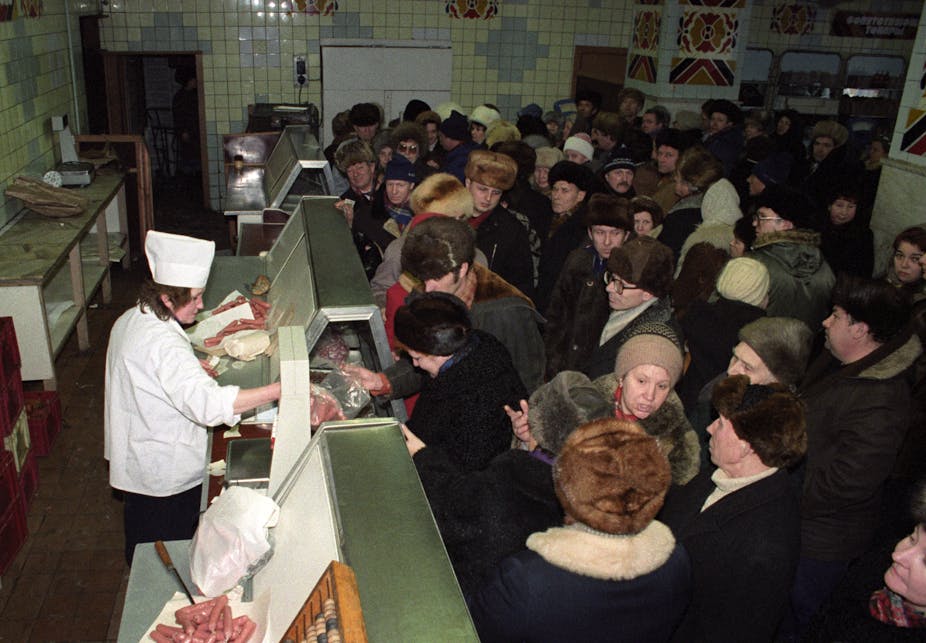Can the world really press the pause button on the economy for months without mass unemployment? The experience of the Russian Federation as it emerged from the central planning of the Soviet Union nearly 30 years ago may provide some indications of what is to come.
When the USSR collapsed in 1991, many western economists advised the post-Soviet states to enact a process of “shock therapy” designed to quickly move the centrally planned economies of the communist era, to market-based systems.
Within months the Russian ruble floated freely on exchange markets, barriers to international trade were lifted, and a mass privatisation process of state-owned enterprises had begun. The economic and social stability of the past was replaced by almost immediately by hyperinflation and the influx of western consumer goods.
In a report for the US government published in 1992, the American economist William Moskoff famously asserted that 30 million, or 25% of the Soviet workforce would be unemployed as a result of the transition from central planning to a market economy. But this expected surge in unemployment did not happen. In reality, unemployment never got higher than 13% in 1998 when Russia experienced a financial crisis due to the default on international debt payments. Prior to this, unemployment hadn’t exceeded 10%, despite the fact that the Russian economy had contracted by 40% between 1991-98.
Officially, between 1993-94, the Russian unemployment rate was 1.5%, lower than nearly every EU country at that time. Others estimate that for every 1% contraction of industrial output, only 0.5% of the labour force was laid off. It appeared, on the surface at least, that the architects of shock therapy and economic transition had performed some kind of miracle, and achieved structural adjustment from communism to capitalism, without mass unemployment.
And yet an unexpected phenomenon was taking place: hidden unemployment.

Listen to Recovery, a series from The Anthill Podcast, to hear more about how the world recovered from past crises, including an episode on the post-Soviet transition in the 1990s.
Employed but not working
Some of the factors contributing to the hidden unemployment problem arose from the policies of the new government of Boris Yeltsin. If firms made people redundant they had to pay severance. If staff were paid a salary more than four times the minimum wage, then the firm would incur additional taxes. This meant that firms had an incentive to keep their wage bill low.
Some workers were sent on long, unpaid holidays or administrative leave either with no pay or very low pay. Others were at work but were not paid. And others were asked to go part time or reduce hours.
It’s estimated that between 1991-98, at any given time, one in four of the Russian workforce was on some form of unpaid or low-paid leave. Many Russians took side jobs in the grey economy to bridge the income gap.
Those in work, but with little to do, clocked in – but then went off moonlighting, driving a taxi for example – and then came back to clock off. In the absence of cash due to the collapse in demand, firms also started to pay their employees in kind, giving them the goods they were producing. Sadly, the value of these goods shrunk to zero as many left the factory to sell the same shoes or tins of paint on every street corner.

The burden of these approaches to labour retention also led to down-skilling as people adapted to the new circumstances by being willing to do any role, regardless of their qualifications and experience to stay working. Many Russians over 55 years of age also withdrew completely from the labour force. Rather than adapt to the new market conditions, many preferred to take their meagre pension and retire to their dachas in the country.
Furlough fragility
There are many parallels with today. In the UK, as of mid-June, around one in four workers were furloughed.
Some UK sectors such as retail and the arts, like sectors of the old Soviet economy, were either in receipt of significant state subsidy, or on life support before COVID-19. With the collapse of Debenhams and other retailers during lockdown, and reports that many arts venues will be out of business by Christmas, it’s likely that many of the jobs from which people are currently furloughed have already been lost.
Daylighting has also emerged, where those on furlough are permitted to take causal work elsewhere. It’s unclear how many of these casual jobs will become permanent once furlough schemes lift. Some people, such as the over-55s in Russia in the 1990s, may also choose to exit or dramatically reduce their participation in the workforce. In the absence of the commute and the flexibility that comes from home working, some may decide to do less, volunteer or retrain for something less stressful – the equivalent of spending time in at their dachas.
Life and death
Yet there was another phenomenon that kept the absolute number of unemployed lower than predicted during the post-Soviet transition in Russia: male life expectancy collapsed.
In 1988, a man could expect to live to 65 in the Soviet Union. By 1994, this had dropped to 57 and did not return to 1988 levels until 2012.
Unemployment – hidden or otherwise – and its social, economic and personal consequences, are a disease in themselves. Pushing the pause button on the economy has undoubtedly saved lives in the short term, but it may cost many more once the cost of hidden unemployment is revealed in years to come.

